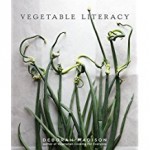 Rarely does a cookbook combine botanical and culinary information with recipes but Deborah Madison’s book, Vegetable Literacy, does it in spades. Drawing on her long experience as a gardener and chef, Madison has created a volume that gives a whole new meaning to the idea of garden to table cooking. She shows how vegetables in the same plant families can be used interchangeably and provides 300 recipes that explore perfect flavor pairings.
Rarely does a cookbook combine botanical and culinary information with recipes but Deborah Madison’s book, Vegetable Literacy, does it in spades. Drawing on her long experience as a gardener and chef, Madison has created a volume that gives a whole new meaning to the idea of garden to table cooking. She shows how vegetables in the same plant families can be used interchangeably and provides 300 recipes that explore perfect flavor pairings.
The book is organized into chapters by vegetable plant family: carrot, mint, sunflower, knotweed, cabbage, nightshade, goosefoot, lily, melon, grass, bean and morning glory. Each chapter begins with a brief description of the family, a list of its culinary members, and anecdotes from the author’s experience. A similar introduction to each culinary member of the family is followed by a series of recipes featuring that member. For example, the chapter on the knotweed family tells us that buckwheat, rhubarb, and sorrel are edible members of the family and share the characteristics of knobs on their stems and a sour taste. The culinary similarities of the family as a whole are discussed and are followed by detailed treatments of each of the three edibles including selected varieties, companion foods, tips for selecting, storing, and cooking, and several recipes including sorrel sauce with yogurt, rhubarb-raspberry compote, and buckwheat tart. The large sunflower family offers recipes such as cardoon risotto, braised endive with gorgonzola, and artichokes with walnut tarator sauce while the cabbage family provides sautéed mustard greens with garlic and peanuts, Brussels sprouts roasted with shallots, and broccoli with curried mayonnaise. Each recipe is introduced with information that includes cooking tips followed by a list of ingredients and clearly written directions. The recipes are suitable for vegetarian cooking but not necessarily for vegans or gluten-free diets. The cooking techniques are varied and easy requiring no special skills while most ingredients can be found in large grocery stores.
The unique approach to cooking and flavor pairing make this book a standout among cookbooks focusing on vegetables. It is especially appealing to readers who like vegetables and have an interest in how cooking works and what flavors go well together. The simplicity of the recipes is another plus as is the easy conversational style and mass of factual material on all aspects of vegetable cooking. A few color photographs enhance the text and a list of recipes and full index make recipes accessible.
To buy Vegetable Literacy from Amazon.com Click Here.